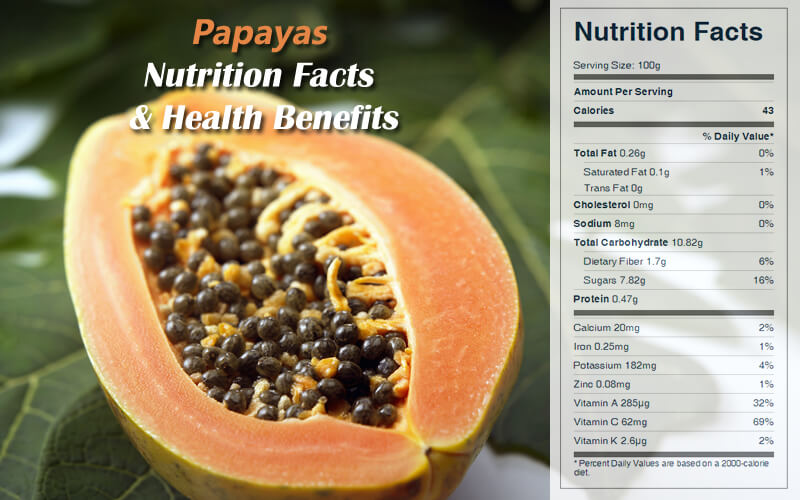Papayas Nutrition Facts & Health Benefits
Papaya is a well-known tropical fruit, enzymes in papaya help to break down food and protect the lining of our gut and digestive tract. Eating papaya before or after a meal has been shown to aid in healthy digestion, here are nutrition facts & health benefits of papayas.
Raw papaya pulp contains 88% water, 11% carbohydrates, is a significant source of vitamin C. Papayas are a rich source of antioxidants and anti-inflammatories, including lutein, alpha and beta-carotene, and vitamin C. They also provide folate, pantothenic acid, potassium, magnesium, and fiber.
The nutritional value of papaya
One medium raw papaya provides 119 calories, 29.8 g carbohydrate, 1.9 g protein, 0.4 g fat, 5.5 g dietary fiber, 863 IU vitamin A, 188 mg vitamin C, 1 mg niacin, 116 mcg folic acid, 781 mg potassium, 9 mg sodium, 15 mg phosphorus, 73 mg calcium, and 30 mg magnesium.

Papaya Nutrition Facts Label
Health Benefits of Papayas
Papaya is high in beta-carotene, vitamins C and E, calcium, magnesium, and potassium. It also contains the protease papain, which is an anticancer agent, and carpaine, an anti-tumorigenic compound.
Papaya fruit, leaves, and seeds were used for different ailments due to its abundance of medicinal properties. This plant contains a wide range of bioactive secondary metabolites, including alkaloids, phenolics, flavonoids, carotenoids, tannins, and saponins. And it has three enzymes: papain, chymopapain, and caricain with additional benefits.
Papayas contain the enzyme papain, which breaks down protein fibers and is used to tenderize tough meats, and which may also help with digestion. This ability to break down proteins allows papain to help relieve the pain of insect and jellyfish stings and bites, because the toxins in these venoms are also proteins.
The enzyme papain is found in the highest concentrations in the milky juice of the unripe papaya—little of it occurs in the ripe fruit. Papain is used to treat allergies, asthma, indigestion, chronic diarrhea, digestive disorders, gluten intolerance, hay fever, sports injuries, and weak lungs, and is dabbed topically on warts. Papain powder is applied to bee stings to reduce pain and inflammation and is also used as a tooth and gum cleanser.
Papain enzyme can improves digestion and is used industrially. They are unique to the papaya fruit! These enzymes have demonstrated immunomodulatory and anti-inflammatory activities. TGFbeta is the cytokine released when IgA antibodies are activated. IgA is the antibody responsible for immune tolerance and typically released as a response to food antigens and other extracellular infections. Studies on rheumatoid arthritis patients have found that papain can significantly reduce TGF-beta.
Another benefit for gut health is that half a papaya contains about 7 grams of fiber, which helps to feed our good bacteria and allow them to flourish! The phytonutrients demonstrate anti-inflammatory, immunomodulatory activity, and antioxidant activity. And the sheer number of phytochemicals in papaya working synergistically with one another produce these benefits. Combining phenolics, alkaloids, carotenoids, glucosinolate, and the enzymes all contribute to making papaya a superfood!
When consumed regularly, papaya improves the health of the skin, hair, nails, and eyes.
The unripe papaya fruit can be mashed and used in facial masks to nourish the skin and lighten freckles, or applied as a poultice for tumors.
Other phytochemicals in papaya from the phenolic, carotenoid, and glucosinolate secondary metabolite compound classes have also been proven to modulate levels of cytokines, transcription factors, and antioxidant enzymes, thus reducing inflammation and modulating the immune system.
Papayas are particularly good for children because they make great-tasting smoothies. Halve and deseed the fruit, put the flesh into a blender, add a small carton of yogurt and a cup of milk, and blend until smooth. For a more sophisticated version for adults, blend the flesh with a little water and mix half and half with champagne.
Health Tips
The papain in papaya can help extract nutrients from your food. So can eating more slowly, chewing food thoroughly increases the production of saliva, which contains amylase, the first step of digestion. Eating more slowly also allows you to appreciate and savor the tastes of your food, as your body absorbs more of its value.
The ripe fruit of the papaya is usually eaten raw, without skin or seeds. Papayas are ripe when their skins are fully red-orange and the fruit feels soft, fully ripened papayas provide the most antioxidant punch. Avoid papayas that seem bruised or that are too soft, but a few black spots are acceptable. Ripe papayas will keep in the refrigerator for a day or two.
The unripe green fruit can be eaten cooked, but not raw due to its poisonous latex content. Green or hard papayas won't get juicy and sweet, because there’s a limit to how much they can ripen once they’ve been picked. Papayas will ripen in the presence of ethylene, so you can speed up the process by putting them in a paper bag with a banana. Green papayas can be used in cooking, especially in some Asian dishes.